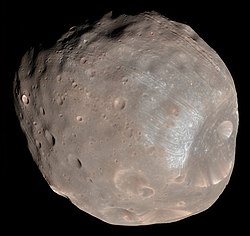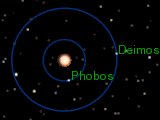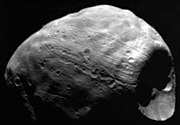 Enhanced-color view of Phobos obtained by Mars Reconnaissance Orbiter on March 23, 2008. | |
| Discovery | |
|---|---|
| Discovered by | Asaph Hall |
| Discovery date | August 18, 1877 |
| Epoch J2000 | |
| Periapsis | 9235.6 km |
| Apoapsis | 9518.8 km |
| Semi-major axis | 9377.2 km[1] |
| Eccentricity | 0.0151 |
| Orbital period | 0.31891023 d (7 h 39.2 min) |
| Average orbital speed | 2.138 km/s |
| Inclination | 1.093° (to Mars' equator) 0.046° (to local Laplace plane) 26.04° (to the ecliptic) |
| Satellite of | Mars |
| Physical characteristics | |
| Dimensions | 26.8 × 22.4 × 18.4 km[2] |
| Mean radius | 11.1 km[3] (0.0021 Earths) |
| Surface area | ~6100 km² (11.9 µEarths) |
| Volume | 5680 km³[4] (5.0 nEarths) |
| Mass | 1.072 × 1016 kg[5] (1.8 nEarths) |
| Mean density | 1.887 g/cm³[4] |
| Equatorial surface gravity | 0.0084–0.0019 m/s² (8.4-1.9 mm/s²) (860-190 µg) |
| Escape velocity | 11.3 m/s (40 km/h)[5] |
| Rotation period | synchronous |
| Equatorial rotation velocity | 11.0 km/h (at longest axis' tips) |
| Axial tilt | 0° |
| Albedo | 0.071[3] |
| Temperature | ~233 K |
| Apparent magnitude | 11.3[6] |
| | |
Phobos (pronounced /ˈfoʊbəs/ FOE-bəs, or as Greek Φόβος) (systematic designation: Mars I) is the larger and closer of Mars' two small moons, the other being Deimos. It is named after the Greek god Phobos (which means "fear"), a son of Ares (Mars). A small, irregularly shaped object, Phobos orbits about 9377 km from the center of Mars, closer to its primary than any other planetary moon.
Discovery

Phobos was discovered by astronomer Asaph Hall, Sr., on August 18, 1877, at the United States Naval Observatory in Washington, D.C., at about 09:14 Greenwich Mean Time (contemporary sources, using the pre-1925 astronomical convention that began the day at noon, give the time of discovery as August 17 16:06 Washington mean time).[7][8][9] Hall also discovered Deimos, Mars' other moon.
The names, originally spelled Phobus and Deimus respectively, were suggested by Henry Madan (1838–1901), Science Master of Eton, from Book XV of the Iliad, where Ares summons Dread (Deimos) and Fear (Phobos).[10][11]
Physical characteristics

Phobos is one of the least-reflective bodies in the solar system. Spectroscopically it appears to be similar to the D-type asteroids,[12] and is apparently of composition similar to carbonaceous chondrite material.[13] Phobos' density is too low to be solid rock, however, and it is known to have significant porosity.[14][15][16] These results led to the suggestion that Phobos might contain a substantial reservoir of ice. Spectral observations indicate that the surface regolith layer lacks hydration,[17][18] but ice below the regolith is not ruled out.[19]
Faint dust rings produced by Phobos and Deimos have long been predicted but attempts to observe these rings have, to date, failed.[20] Recent images from Mars Global Surveyor indicate that Phobos is covered with a layer of fine-grained regolith at least 100 meters thick; it is believed to have been created by impacts from other bodies, but it is not known how the material stuck to an object with almost no gravity.[21]
Phobos is highly nonspherical, with dimensions of 27 × 22 × 18 km.[2] Because of its shape alone, the gravity on its surface varies by about 210%; the tidal forces raised by Mars more than double this variation (to about 450%) because they compensate for a little more than half of Phobos' gravity at its sub- and anti-Mars poles.[citation needed]
Phobos is heavily cratered.[22] The most prominent surface feature is Stickney crater, named after Asaph Hall's wife, Angeline Stickney Hall, Stickney being her maiden name. Like Mimas's crater Herschel on a smaller scale, the impact that created Stickney must have almost shattered Phobos.[23] Many grooves and streaks also cover the oddly shaped surface. The grooves are typically less than 30 m deep, 100 to 200 m wide, and up to 20 km in length, and were originally assumed to have been the result of the same impact that created Stickney. Analysis of results from the Mars Express spacecraft, however, revealed that the grooves are not in fact radial to Stickney, but are centered on the leading apex of Phobos in its orbit (which is not far from Stickney), and must have been excavated by material ejected into space by impacts on the surface of Mars.[24] The grooves thus formed as crater chains, and all of them fade away as the trailing apex of Phobos is approached. They have been grouped into 12 or more families of varying age, presumably representing at least 12 Martian impact events.[24]
The unique Kaidun meteorite is thought to be a piece of Phobos, but this has been difficult to verify since little is known about the detailed composition of the moon.[25]
Orbital characteristics
Phobos' unusually close orbit around its parent planet produces some unusual effects.
As seen from Phobos, Mars would appear 6400 times larger and 2500 times brighter than the full Moon appears from Earth, taking up a quarter of the width of a celestial hemisphere.
Phobos orbits Mars below the synchronous orbit radius, meaning that it moves around Mars faster than Mars itself rotates. Therefore it rises in the west, moves comparatively rapidly across the sky (in 4 h 15 min or less) and sets in the east, approximately twice a day (every 11 h 6 min). Since it is close to the surface and in an equatorial orbit, it cannot be seen above the horizon from latitudes greater than 70.4°.
As seen from Mars' equator, Phobos would be one-third the angular diameter of the full Moon as seen from Earth. Observers at higher Martian latitudes would see a smaller angular diameter because they would be significantly farther away from Phobos. Phobos' apparent size would actually vary by up to 45% as it passed overhead, due to its proximity to Mars' surface: for an equatorial observer, for example, Phobos would be about 0.14° upon rising and swell to 0.20° by the time it reaches the zenith. By comparison, the Sun would have an apparent size of about 0.35° in the Martian sky.
Phobos' phases, in as much as they could be observed from Mars, take 0.3191 days (Phobos' synodic period) to run their course, a mere 13 seconds longer than Phobos' sidereal period.
Solar transits
An observer situated on the Martian surface in a position to observe Phobos would see regular transits of the moon across the Sun. Phobos is not large enough to cover the Sun's disk, and so cannot cause a total eclipse. Several of these transits have been photographed by the Mars Rover Opportunity. During the transits, Phobos' shadow is cast on the surface of Mars, which has been photographed by several spacecraft.
Future destruction
Phobos' low orbit means that it will eventually be destroyed: tidal forces are lowering its orbit, currently at the rate of about 20 meters per century, and in 11 million years it will either impact the surface of Mars or (more likely) break up into a planetary ring.[26] Given Phobos' irregular shape and assuming that it is a pile of rubble (specifically a Mohr-Coulomb body), it has been calculated that Phobos is currently stable with respect to tidal forces. But it is estimated that Phobos will pass the Roche Limit for a rubble pile when its orbital radius drops by a little over 2000 km to about 7100 km. At this distance Phobos will likely begin to break up and form a short lived ring system around Mars. The rings themselves will then continue to spiral slowly into Mars.[27]
Origin
The origin of the Martian moons is still controversial.[28] Phobos and Deimos both have much in common with carbonaceous C-type asteroids, with spectra, albedos and densities very similar to those of C- or D-type asteroids.[12] Based on this similarity, one hypothesis is that both moons may have been captured into Martian orbit from the main asteroid belt.[29][30] Both moons have very circular orbits which lie almost exactly in Mars' equatorial plane, and hence a capture origin requires a mechanism for circularizing the initially highly-eccentric orbit, and adjusting its inclination into the equatorial plane, most likely by a combination of atmospheric drag and tidal forces,[31] although it is not clear that sufficient time is available for this to occur for Deimos.[28] Capture also requires dissipation of energy. The current Mars atmosphere is too thin to capture a Phobos-sized object by atmospheric braking.[28] Geoffrey Landis has pointed out that the capture could have occurred if the original body was a binary asteroid that separated due to tidal forces.[30] The main alternative hypothesis is that the moons accreted in the present position. Another hypothesis is that Mars was once surrounded by many Phobos- and Deimos-sized bodies, perhaps ejected into orbit around it by a collision with a large planetesimal.[32]
"Hollow Phobos" suggestions
In the late 1950s and 1960s, the unusual orbital characteristics of Phobos led to speculations that it might be hollow.
Around 1958, Russian astrophysicist Iosif Samuilovich Shklovsky, studying the secular acceleration of Phobos' orbital motion, suggested a "thin sheet metal" structure for Phobos, a suggestion which led to speculations that Phobos was of artificial origin.[33] Shklovsky based his analysis on estimates of the upper Martian atmosphere's density, and deduced that for the weak braking effect to be able to account for the secular acceleration, Phobos had to be very light —one calculation yielded a hollow iron sphere 16 km across but less than 6 cm thick.[33][34] In a February 1960 letter to the journal Astronautics,[35] S. Fred Singer, then science advisor to U.S. President Dwight D. Eisenhower, came out in support of Shklovsky's theory, stating:
| “ | [Phobos'] purpose would probably be to sweep up radiation in Mars' atmosphere, so that Martians could safely operate around their planet. "My conclusion there is, and here I back Shklovsky, that if the satellite is indeed spiraling inward as deduced from astronomical observation, then there is little alternative to the hypothesis that it is hollow and therefore martian made. The big 'if' lies in the astronomical observations; they may well be in error. Since they are based on several independent sets of measurements taken decades apart by different observers with different instruments, systematic errors may have influenced them.[35] | ” |
Subsequently, however, the existence of the acceleration that had caused the claims was called into doubt,[36] and accurate measurements of the orbit available by 1969 showed that the discrepancy did not exist.[37] Singer's critique was justified when earlier studies were later discovered to have used an overestimated value of 5 cm/yr for the rate of altitude loss, which was later revised to 1.8 cm/yr.[38] The secular acceleration is now attributed to tidal effects, which had not been considered in the earlier studies. The density of Phobos has now been directly measured by spacecraft to be 1.887 g/cm³[4], which is inconsistent with a hollow shell. In addition, images obtained by the Viking probes in the 1970s clearly showed a natural object, not an artificial one, and the "hollow Phobos" speculations have been relegated to the status of a historical curiosity.
Exploration
Past missions
Phobos has been photographed in close-up by several spacecraft whose primary mission has been to photograph Mars. The first was Mariner 9 in 1971, followed by Viking 1 in 1977, Mars Global Surveyor in 1998 and 2003, Mars Express in 2004 and 2008, and Mars Reconnaissance Orbiter in 2007 and 2008. The only dedicated Phobos probes have been the Soviet Phobos 1 and Phobos 2; the first was lost en route to Mars, and the second returned documented, unusual data and images before failing prior to its detailed examination of the moon.
Future missions
The Russian Space Agency is planning to launch a sample return mission to Phobos in 2009, called Phobos-Grunt. The return capsule will include a life science experiment of The Planetary Society, called Living Interplanetary Flight Experiment, or LIFE. [39] A second contributor to this mission is China with a surveying satellite called "Yinghuo-1" that will be released in the orbit of Mars, and a soil grinding and sieving system for the scientific payload of the Phobos lander.[40][41][42]
Astrium in the UK is also planning a sample return mission.[43]
Phobos has also been proposed as an early target for a Manned mission to Mars,[44] since a landing on Phobos would be considerably less difficult (and hence, much less expensive) than a landing on the surface of Mars itself.
Named geological features
Geological features on Phobos are named after astronomers who studied Phobos and people and places from Jonathan Swift's Gulliver's Travels.[45] The only named ridge on Phobos is Kepler Dorsum, named after the astronomer Johannes Kepler. Several craters have been named.[46]
| Crater | Named after |
|---|---|
| Clustril | Character in Gulliver's Travels |
| D'Arrest | Heinrich Louis d'Arrest, astronomer |
| Drunlo | Character in Gulliver's Travels |
| Flimnap | Character in Gulliver's Travels |
| Gulliver | Main character of Gulliver's Travels |
| Hall | Asaph Hall, discoverer of Phobos |
| Limtoc | Character in Gulliver's Travels |
| Reldresal | Character in Gulliver's Travels |
| Roche | Édouard Roche, astronomer |
| Sharpless | Bevan Sharpless, astronomer |
| Skyresh | Character in Gulliver's Travels |
| Stickney | Angeline Stickney, wife of Asaph Hall |
| Todd | David Peck Todd, astronomer |
| Wendell | Oliver Wendell, astronomer |
Phobos in fiction
In the satire Gulliver's Travels by Jonathan Swift, the inhabitants of Laputa claim to have discovered two moons of Mars. This is why names from Gulliver's Travels are used for features on the moons of Mars. Swift's classic was written over 150 years before Phobos and Deimos were discovered by Asaph Hall.
In Arthur C. Clarke's novel The Sands of Mars, Mars is terraformed when Phobos is ignited as a second sun using a meson-resonance reaction, and in the novel The Fountains of Paradise, Phobos presents an obstacle to the construction of a space elevator on Mars due to its close orbit. In the short story Hide and Seek, Phobos is the scene of a seemingly unequal encounter between an agent forced to land on the tiny moon and a military spaceship pursuing him.
James Blish's novella "Mission to the Heart Stars" begins with several astronauts examining the interior of Phobos, which turns out to be an artificial surveillance satellite placed in Mars orbit to study the Solar system by the Hegemony of Malis - an alien political collective that inhabit the star systems near the hub of the Milky Way (the 'Heart Stars' of the title).
The Mars Trilogy by Kim Stanley Robinson is the chronicling of the settlement and terraforming of the planet Mars. In this series, a weapon system built into Phobos is activated, which causes the entire moon (which at that time is a transnational military base) to decelerate in orbit and destructively aerobrake in Mars' atmosphere, utterly destroying it.




0 comments:
Post a Comment